In Part 21 of the Addenda to the Revised Crime Fiction IV is the following entry, which after I’ve expanded it a little, includes just about all that’s known about either the author or the publisher.
DAY, LULA M(ADELAINE). 1902?-1992?
The Mystery of the Red Suitcase. Virginia: Hip Books, pb, February 1946. Add setting: Calumet, Indiana. Leading characters: Miss Lula Day, Squire Dunnett & Lt. Inspector Steve Badger. Note: Eleven other titles by this author were announced but none was published; all apparently were to have the same leading characters. [In Chapter One of this book, the man found shot in Miss Day’s garden turns out to be her ex-brother-in-law. Investigating the crime is Lt. Badger. Squire Dunnett is an aged attorney; as it happens, “Squire” is his first name.]
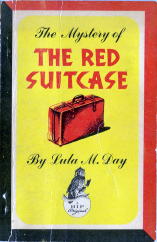 The book is a regular paperback in size, although perhaps a trifle slimmer than others published in 1946 – thinner paper perhaps, as in all it’s 232 pages long, or in other words, a full-sized novel. This is the only book that Hip Books seems to have published, although as you will soon see, others were definitely in the planning stages. The only address given for Hip is Alexandria, Virginia, not exactly the publishing capital of the US, then or now.
The book is a regular paperback in size, although perhaps a trifle slimmer than others published in 1946 – thinner paper perhaps, as in all it’s 232 pages long, or in other words, a full-sized novel. This is the only book that Hip Books seems to have published, although as you will soon see, others were definitely in the planning stages. The only address given for Hip is Alexandria, Virginia, not exactly the publishing capital of the US, then or now.
On the title page it says, under the Hip Books line, that the book was published “under arrangement with Owl Press, Inc.” Sherrie Tellier has followed up on this lead and reports back that “Owl Press is still in existence, but claims not to have any information on this book.”
Not surprisingly, as it’s my feeling that Owl Press was hired to do the finished product only as an outside job, and they had nothing to do with the book from the editorial end.
Oh, one more thing, before I get to the author herself, Lula M. Day. There’s nothing on the back cover but general information about Hip Books, and nothing about the story itself. You may have gotten the same impression about name of the company as I did, but no, the tagline for the one-book publishing firm is “They fit your hip.”
It would seem as though tracking Lula Day down would be easy. How many Lula Day’s could there have been? The answer is another surprise. Lots of them, and believe it or not, she’s not the only Lula M. Day who shows up on Google. The dates as given above are extremely tentative, and come from this lady:
Lula M. DAY was born on 9 Nov 1902 in Ross Co., OH. She appeared in the census in Apr 1930 in Chillicothe, Ross, OH. She died on 11 Dec 1992 in Chillicothe, Ross, OH. Parents: Ellis Day and Ella Willison.
The book takes place in Indiana, and Ohio is the next state over, making this my choice. Al Hubin has countered with:
“If the publication of her book in Virginia is any clue, a Lula Day (no middle initial given) was born Oct 12 1899 in Virginia and died Nov 1 1988. And a Lula Day (no m.i.) was born April 18 1896, and her ss# was issued in Virginia (she died there in July 1984).”
If you were to search online yourself, you’d come up with at least one other Lula M. Day, perhaps two. (It is not clear whether the two I just found are the same person or not.)
This is all that various researchers, including Victor Berch, have come up with so far. We’ve all come to the same dead ends. Perhaps by posting even these incompleat results, someone will stop by, discover what we’ve found, and tell us more. That’s what we’re hoping.
I’ve not read the book, but I’ve skimmed through the first couple of chapters, and at glance one and two, the story-telling appears solid enough. There are plenty of other reasons why there there were to be no more books from either Lula Day or Hip Books, but they did have plans, as I alluded to up above.
What comes after THE END? [At the bottom of page 227.] Steve Badger has just proposed to Lula Day, upon which she “came unglued all at once.”
And on the next page:
AND SO THEY WERE MARRIED
(More About Steve and Lula Badger)
2. “THE MYSTERY OF THE CAT THAT CAME BACK” …
Started on a motor honeymoon to California, McNulty’s wire reached them at Topeka, Kan. The wife of the city’s wealthiest manufacturer had fantastically vanished from her bed in the night; next night her frantic husband similarly disappeared; the third night it was their bachelor son. Was it kidnapping or the supernatural? Reluctantly the Badgers interrupted their wedding-trip. But the night they returned to Calumet to help solve the case, the missing woman’s huge Persian cat reappeared in the house. Lula writes in the first person how the clue of the Cat led to Chicago and Wisconsin and finally cracked the mystery wide open. . . .
3. “THE MYSTERY OF THE TALKING CARPET”
Arrived in Hollywood at the home of Lula’s relatives, Steven becomes embroiled in a different enigma. A waitress in a Drive-In Stand has been summoned home by plane to Arizona. Suddenly the plane veers over the Pacific and the girl is hurled out, falling so peculiarly that she lives to tell the story. Steven becomes interested. Quickly he develops a still greater mystery, involving well-known movie people, which he solves by a ruse of the girl’s bedroom carpet. Another inspirational detective mystery rich in the atmosphere of picturedom.
4. “THE MYSTERY OF THE WALKING SUSPENDERS” . . .
Returned to Calumet and ensconced in their new home in County Downe suburb, a wealthy Irish contractor is discovereddead in his skyscraper office with an arrow in his back and open window behind him. The contractor’s fine son is suspected of the killing. Steven follows the case to a night when rank upon rank of mysterious suspenders are seen “marching” in the darkness across the grounds of a country estate. In one of her most poignant and realistic stories, Miss Day tells the secret of the phenomena and the reconciliation that follows with the son’s wife when Steven – with Squire Dunnett’s aid – proves how the arrow reached the father’s back. , . .
5. “THE MYSTERY OF THE LAUGHING NUGGET” …
An eccentric old bank president is found frozen to death in his home in a town near Calumet. The coroner declares he has not died naturally and county authorities “borrow” Steven’s service. to determine the cause of death, and – if necessary- — apprehend his slayers. Steven and Lula find bloody tracks in an upper room that seem to disappear into a doorless wall. Finally a sizable gold nuggett is located on which is engraved a grinning face, opening an Alaskan chapter in the victim’s. life where the secret of his death is found, Squire Dunnett at his best in this volume. . .
6. “THE MYSTERY OF THE STRAWBERRY BLOUSE” …
An Indiana farmhand, cutting diagonally across a cornfield to catch a bus, notices a peculiar “cornstock” rising ten inches above the soil. Looking closer, he is horrified to recognize it as the hand of a woman. Presently the body of a girl is disinterred from her make-shift grave. Pinned to her “strawberry blouse” is an address in town for police to investigate. When the housewife at the address is summoned to identify the body at the morgue, she stuns authorities by screaming that the dead girl is herself at 23 years old. Furthermore, the dead girl’s clothes are identified as having been worn by the housewife at a party at the age she has indicated. Lula describes how Badger runs up against a wall in this one, but shrewd old Squire Dunnett traces the mystery to Chicago and developes an explanation that makes the case unique …
7. “THE MYSTERY OF THE MOON’S BREAKFAST” …
Six Scot brothers, reputable citizens of Calumet, die off a week apart by mysterious poisoning. With no hidden scandals in their lives that Badger can discover, the safe deposit box of the eldest is opened and a little bag of buttons comes to light, along with vague papers about “the moon’s breakfast.” In the midst of investigation into their deaths, Steven and Lula have a strange and bizarre guest at County Downe, their suburban home – apparently a foreign nobleman – who talks wildly of revolutions. Subsequently this personage is involved in Steve’s and Lula’s abductions while Squire Dunnett drops tragically from sight, and Lula, shut in an abandoned auto factory, almost loses her life. In the end the bag of buttons, the “nobleman” and the abductions, are uniquely tied together – and it isn’t a revolution. One of Miss Day’s best. . . .
8. “THE MYSTERY OF THE HAUNTED COFFEE-CUP” …
Badger’s growing. reputation as a homicide sleuth causes him to be retained by a Chicago millionaire to investigate someone impersonating him back east. Steven and Lula journey to Vermont, find the “millionaire” as purported to have died and been buried the week before, but when the impersonator’s family vault is opened nothing is found within the casket but an old-fashioned moustache cup, with saucer. Convinced it has significance and is not a hoax, Steven follows the trail of the coffee-cup to Philadelphia and Florida, then back to Vermont. The reason the impersonation and the presence of the cup in the casket tie together one of the most poignant stories in the Lula Day series. . . .
IN MISS DAY’S STENOGRAPHIC BOOKS FOR FUTURE PUBLICATION
“The Mystery of the Flying Elephant”
“The Mystery of the Spinster’s Bedroom”
“The Mystery of the Screaming Village”
“The Mystery of the Thing Against the Moon”
None of these, as far as can be determined, was ever printed. What would be interesting to discover is whether any or all of them were ever written.

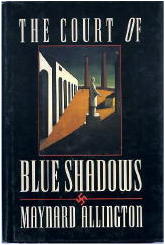
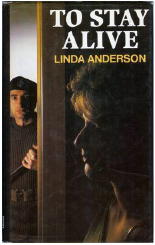


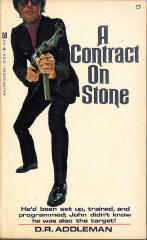
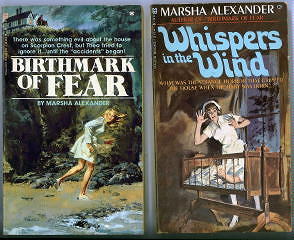
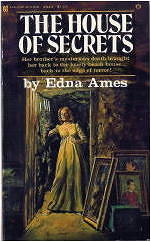
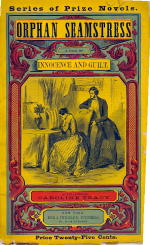
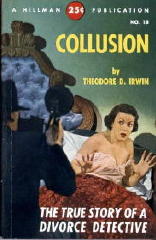
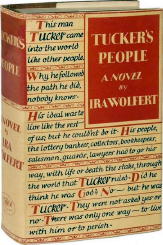
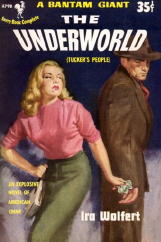







 The book is a regular paperback in size, although perhaps a trifle slimmer than others published in 1946 – thinner paper perhaps, as in all it’s 232 pages long, or in other words, a full-sized novel. This is the only book that Hip Books seems to have published, although as you will soon see, others were definitely in the planning stages. The only address given for Hip is Alexandria, Virginia, not exactly the publishing capital of the US, then or now.
The book is a regular paperback in size, although perhaps a trifle slimmer than others published in 1946 – thinner paper perhaps, as in all it’s 232 pages long, or in other words, a full-sized novel. This is the only book that Hip Books seems to have published, although as you will soon see, others were definitely in the planning stages. The only address given for Hip is Alexandria, Virginia, not exactly the publishing capital of the US, then or now.